Lower elm path
Lower elm path
An ancient field now part of the Recreation Ground
Originally part of the great medieval Middle Field of Kingston Manor, a sub-field called Pikes covered a large area in the region of Marsh Lane and Combe Street Lane. It was still called Pikes and is noted as such on an indenture dated 1800. The name changed however to become Elm Path.
At one time there was a continuous footpath from Yeovil to Yeovil Marsh and eventually to Ilchester by footpaths and lanes. It started at Kingston at Red Lion Lane, continued along Sparrow Lane to Mudford Road then crossed the road and entered a single large field called Elm Path (the field name was a corruption of an earlier name of the footpath - Hellam Path, referred to as Hillon Path in the 1589 Terrier) that ran all the way to Combe Street Lane and then onwards to Yeovil Marsh.
By Victorian times this large field, Elm Path was part of Lower Stone Farm and had been subdivided into Higher Elm Path (1094), Middle Elm Path (1086) and Lower Elm Path (1081). Today these three fields form the Yeovil Recreation Centre, affectionately known as 'Mudford Rec', and remain the only open green area in the Hollands section.
Lower Elm Path (actually sub-divided into 1081 and 1081a but not shown as such on my map) was bounded to the north by Middle Elm Path (1086), to the west by Behind the House (1084), to the west by Green Cross (1080) and to the south by Hundred Acres (1079, Hollands Farm and Quarry Plot (1076). The southeastern corner of Lower Elm Path was extended to Mudford Road in order to continue the footpath from Sparrow Path.
The 1842 Tithe Map and the 1846 Tithe Apportionment recorded Lower Elm Path (1081) as being owned by Henry Goodford of Chilton Cantelo and the tenant was John Newman Berkley. The acreages were recorded as 3a 3r 30p and (1081a) as 3a 2r 0p and both parts noted as arable, that is, suited to the plow and for tillage and therefore used for producing crops.
On 30 August 1849 Henry Goodford Esq. of Chilton Cantelo, leased to baker Nathaniel Bartlett of Yeovil, the following parcels of land, Land late in occupation of Mr John Newman-Birkley in Yeovil for £172. 10s -
-
a cottage and garden Hundred Acres - 3a 2r 20p
-
Stoney Field and Green Close - 8a 2r 10p
-
Higher Elm Path - 7a 2r 12p
-
Middle Elm Path - 8a 3r 35p
-
Lower Elm Path - 7a 1r 20p
-
Coombe Street - 5a 2r 10p
-
Beacon - 16a 2r 10p
-
Total 58a 1r 26p
Today most of Lower Elm Path is taken up with the athletics arena of Yeovil Recreation Centre.
During 2013 salvage excavations recorded parts of a previously unknown late Iron Age and Roman settlement, discovered during earthmoving for sports pitches. The site was reported following the discovery of a hoard of 3,339 coins by the digger driver. Experts established that the coins were from the 2nd-3rd centuries AD, with 164 being dinarii, four brass sestertii, and the rest radiates. Some coins had been stacked and carefully bound in textile, and string, some of which remained. Some of the coins carried the heads of empresses, and others emperors, including Philip I, born in Syria of a Syrian father, around 204AD.
To the east of the hoard, the settlement was represented by pits and ditches forming incomplete enclosures. There was also a four-post structure and evidence for some metalworking activity. It is possible that the coins, specimens of which are shown below, were intended as a source of metal for reworking although iron working is more likely. The presence of the coins and imported pottery suggests that the inhabitants had some degree of wealth and the site is likely to extend further.
For details on historic land measurement (ie acres, roods and perches) click here.
map
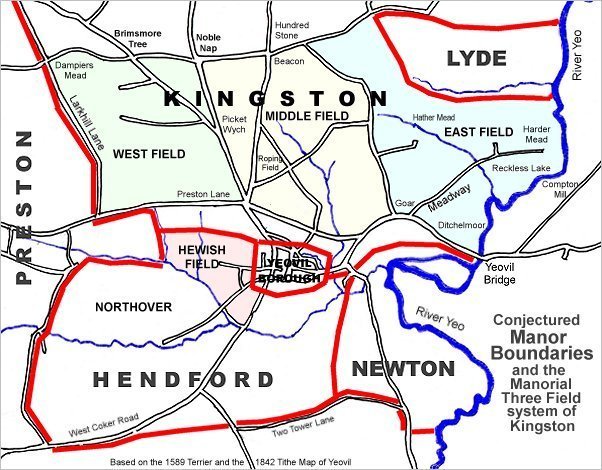
This map, based on the descriptions in the 1589 Terrier and the 1846 Tithe Map of Yeovil shows the approximate boundaries of the Manors of Kingston and Hendford as well as the manorial three-field system used in Kingston.
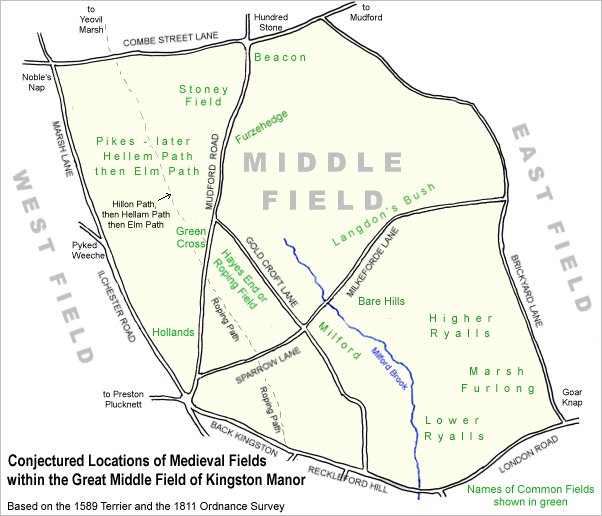
A conjectural map of the great Middle Field of Kingston Manor.
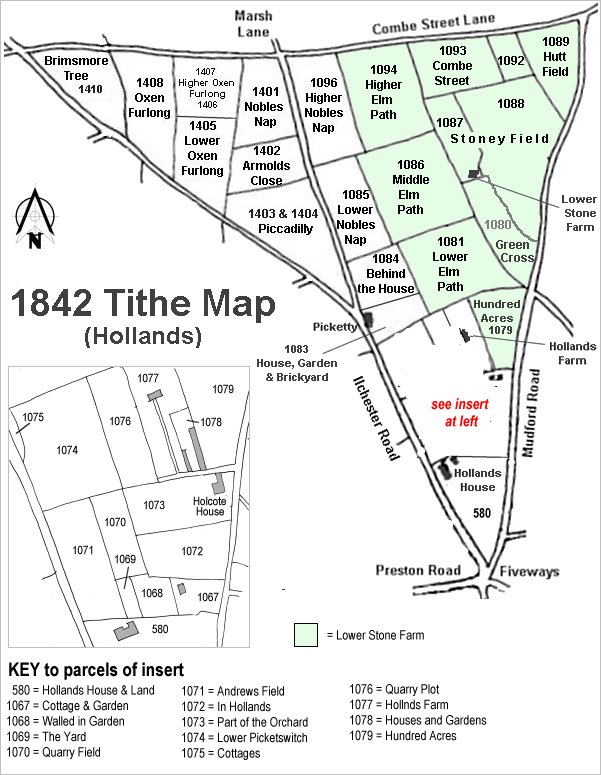
The Hollands area reproduced from the 1842 Tithe Map. Middle Elm Path is right of centre.
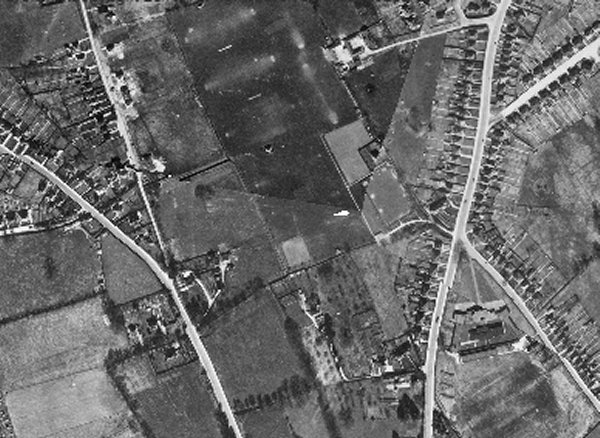
The 1946 aerial photograph showing Lower Elm Path at centre with a lighter rectangle in its bottom left corner.
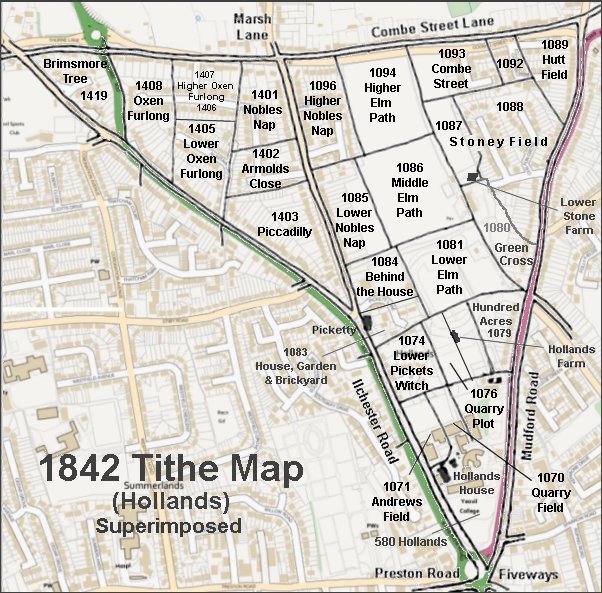
The 1842 Tithe Map superimposed over a modern map.
Gallery
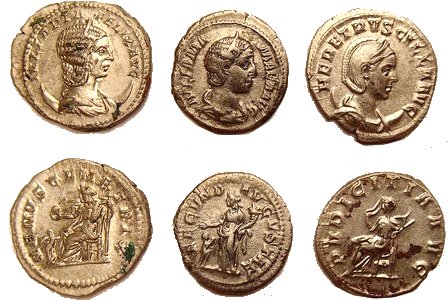
The Roman coins, mainly of silver, found on the former Lower Elm Path, include depictions of an elephant and a hippopotamus, animals which must have seemed exotic monsters to the Romano Britons through whose hands they passed. The hoard is thought to have been buried around 270AD.
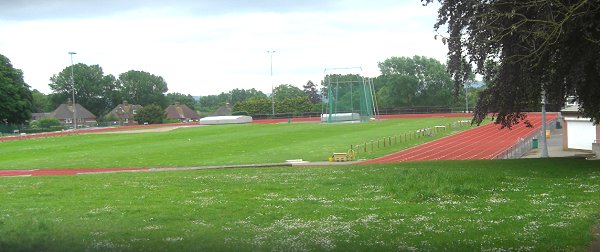
Lower Elm Path, now the athletics stadium, seen from the southeast corner of Middle Elm Path. Lower Elm Path ended about where the high nets are in the centre of the picture, beyond which was Quarry Plot and Hollands Farm. Photographed in 2014.